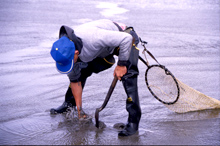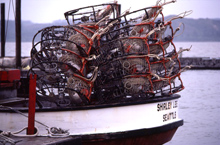Our Programs | CZM
The National Coastal Zone Management Program

It is important to protect our natural resources so future generations can also enjoy activities such as razor clamming.
The National Coastal Zone Management (CZM) Program is a voluntary partnership between the federal government and U.S. coastal states and territories authorized by the Coastal Zone Management Act of 1972. The Coastal Programs Division, within the National Oceanic and Atmospheric Administration's Office of Ocean and Coastal Resource Management, administers the program at the federal level and works with state coastal zone management partners to balance coastal development with resource conservation.
Working with State Coastal Management Program Partners
Thirty-four coastal and Great Lakes states, territories and commonwealths have approved coastal management programs. Together, these programs protect more than 99 percent of the nation's 95,331 miles of ocean and Great Lakes coastline.
To comprehensively manage our coastal resources and balance often competing land and water uses while protecting sensitive resources, state coastal zone management programs are expected to:
- Protect natural resources;
- Manage development in high hazard areas;
- Manage development to achieve quality coastal waters;
- Give development priority to coastal-dependent uses;
- Have orderly processes for the siting of major facilities;
- Locate new commercial and industrial development in, or adjacent to, existing developed areas;
- Provide public access for recreation;
- Redevelop urban waterfronts and ports
- preserve and restore historic, cultural, and aesthetic coastal features;
- Simplify and expedite governmental decision-making actions;
- Coordinate state and federal actions;
- Give adequate consideration to the views of federal agencies;
- Assure that the public and local governments have a say in coastal decision-making; and
- Comprehensively plan for and manage living marine resources.

Crabbing and fishing are important coastal-dependent uses in Washington.
A unique aspect of coastal zone management is "Federal Consistency" which ensures that federal actions that are reasonably likely to affect any land or water use or natural resource of the coastal zone will be consistent with the enforceable policies of a coastal state's or territory's federally approved Coastal Zone Management Program.
In 1990, Congress created a new program under the Coastal Zone Management Act, called the Coastal Zone Enhancement Program. The program provides incentives for states and territories to make changes in any of eight areas of national significance.
Another important component of coastal zone management programs is the Coastal Nonpoint Pollution Control Program. Authorized by Section 6217 of the Coastal Zone Act Reauthorization Amendments of 1990, this amendment requires states and territories with approved coastal zone management programs to develop and implement programs to control nonpoint source pollution from six main sources: agricultural, forestry, urban development, marinas, hydromodifications (such as dams or stream channel modifications), and the loss of wetland and riparian areas.
